An Intrinsic TE Approach for End-to-End QoS Provisioning in OBS Networks Using Static Load-Balanced Routing Strategies
Abstract
:1. Introduction
2. OBS Networks

2.1. IP over OBS Model

2.2. Functional Mechanisms of OBS Nodes
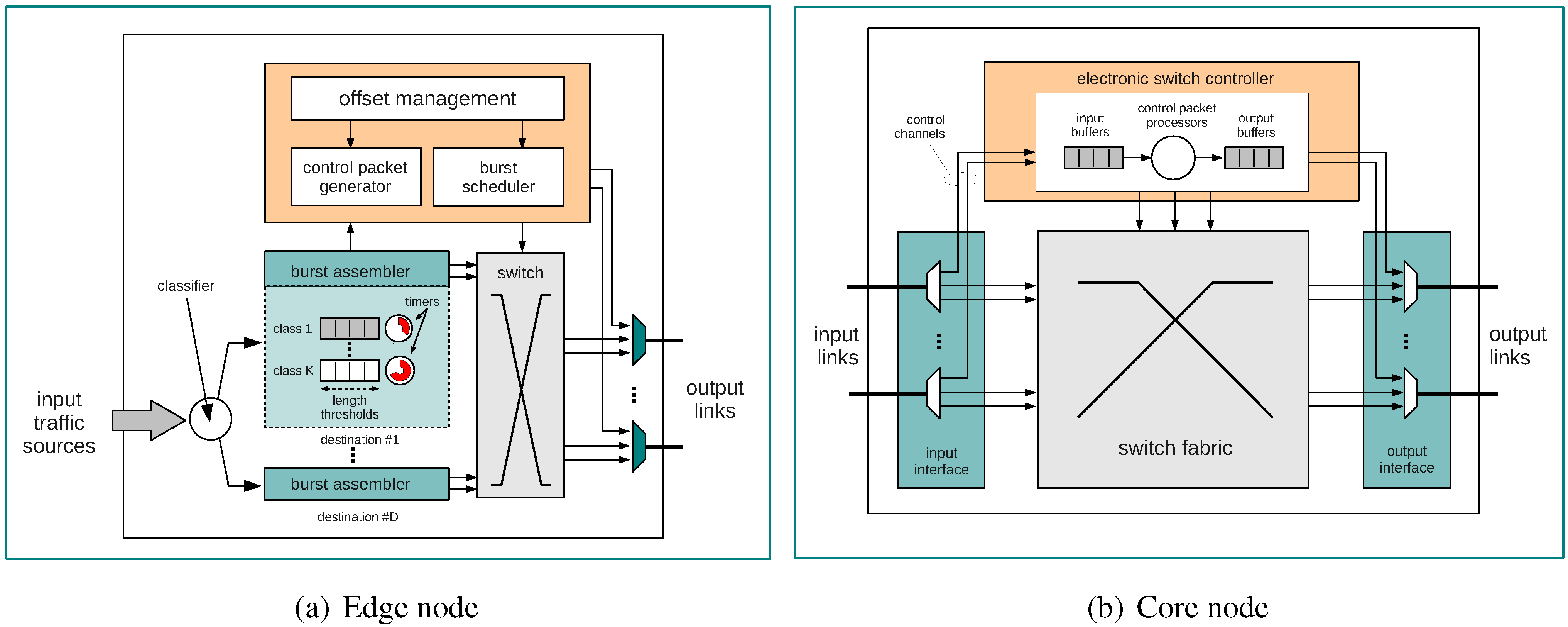
2.2.1. Burst Assembly
2.2.2. Signaling
2.2.3. Routing
2.2.4. Wavelength Assignment
2.2.5. Scheduling of Resources
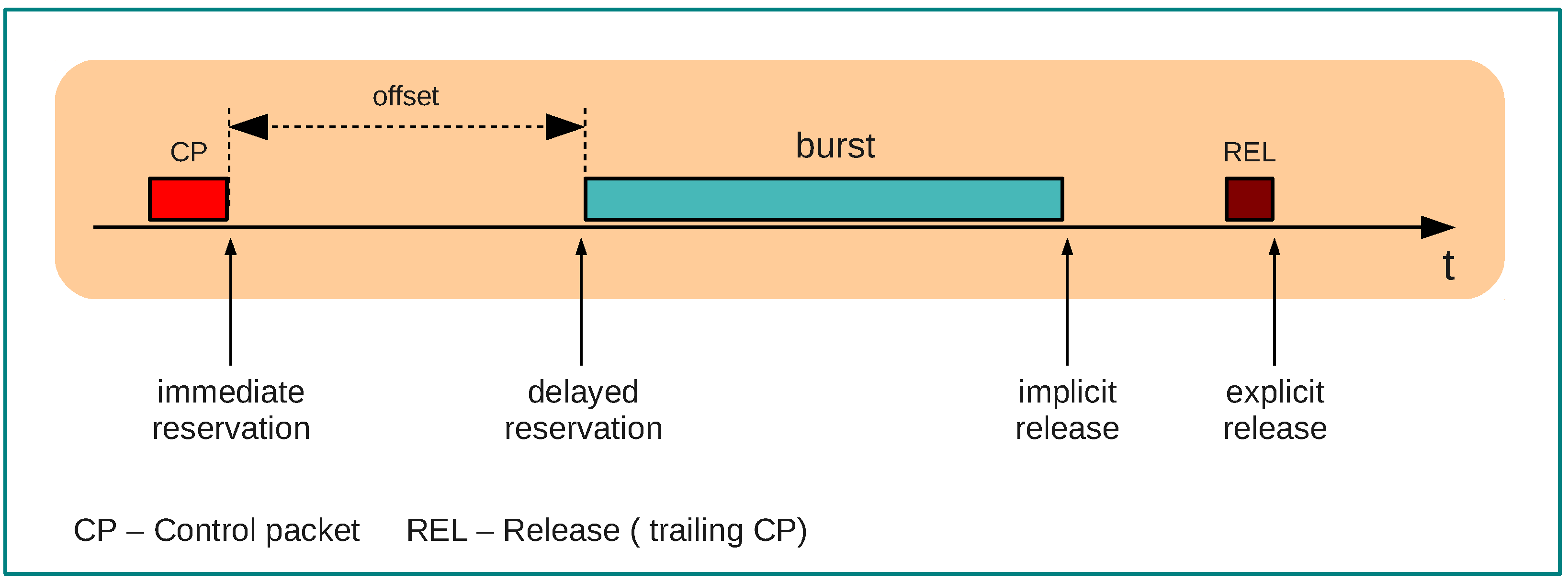
2.2.6. Contention Resolution
2.3. QoS Support

2.3.1. Differentiated QoS Provisioning
2.3.2. Traffic Engineering
3. Simulation Model
3.1. First Stage—Routing Path Determination
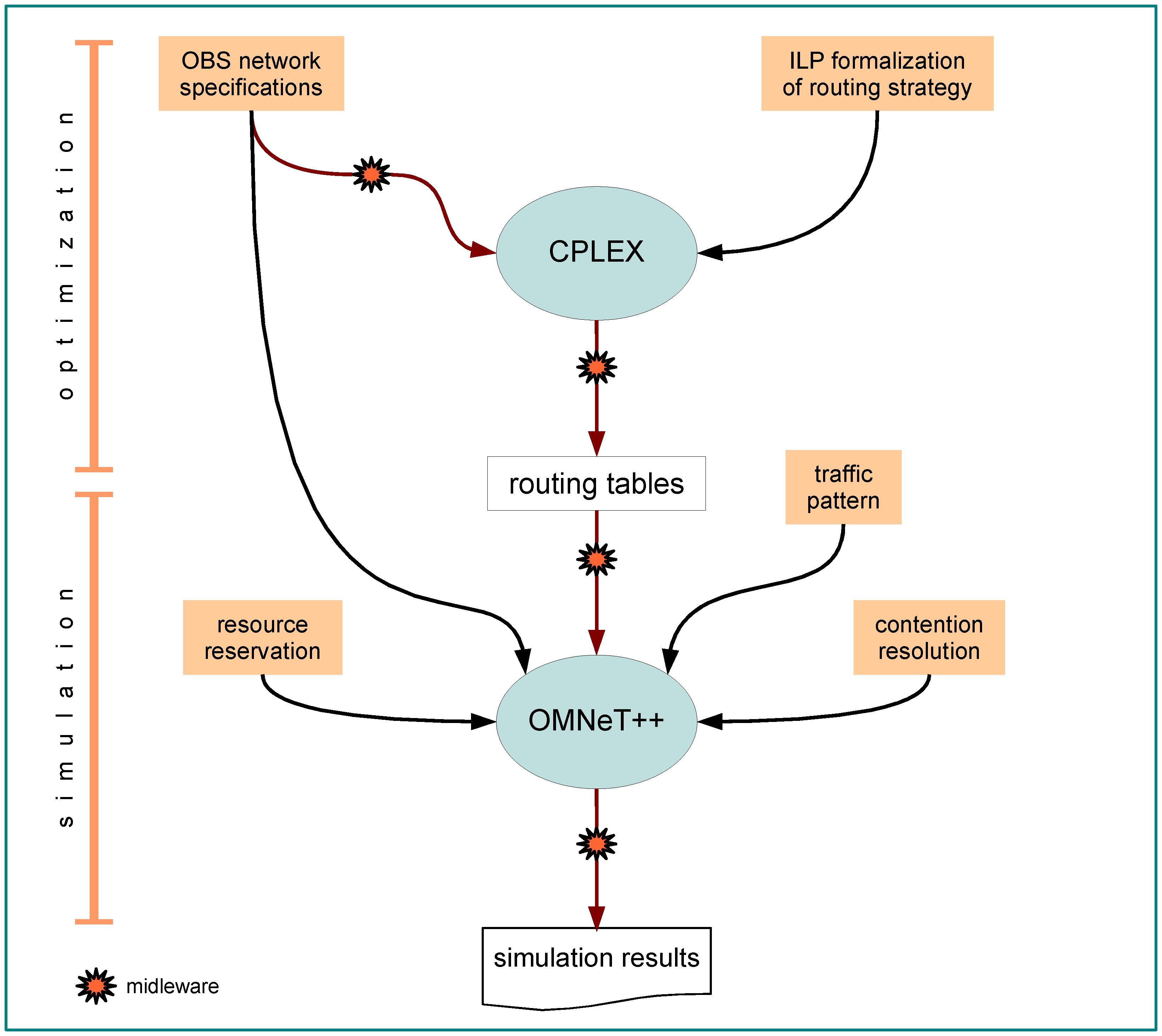
3.2. Second Stage—Routing Path Application
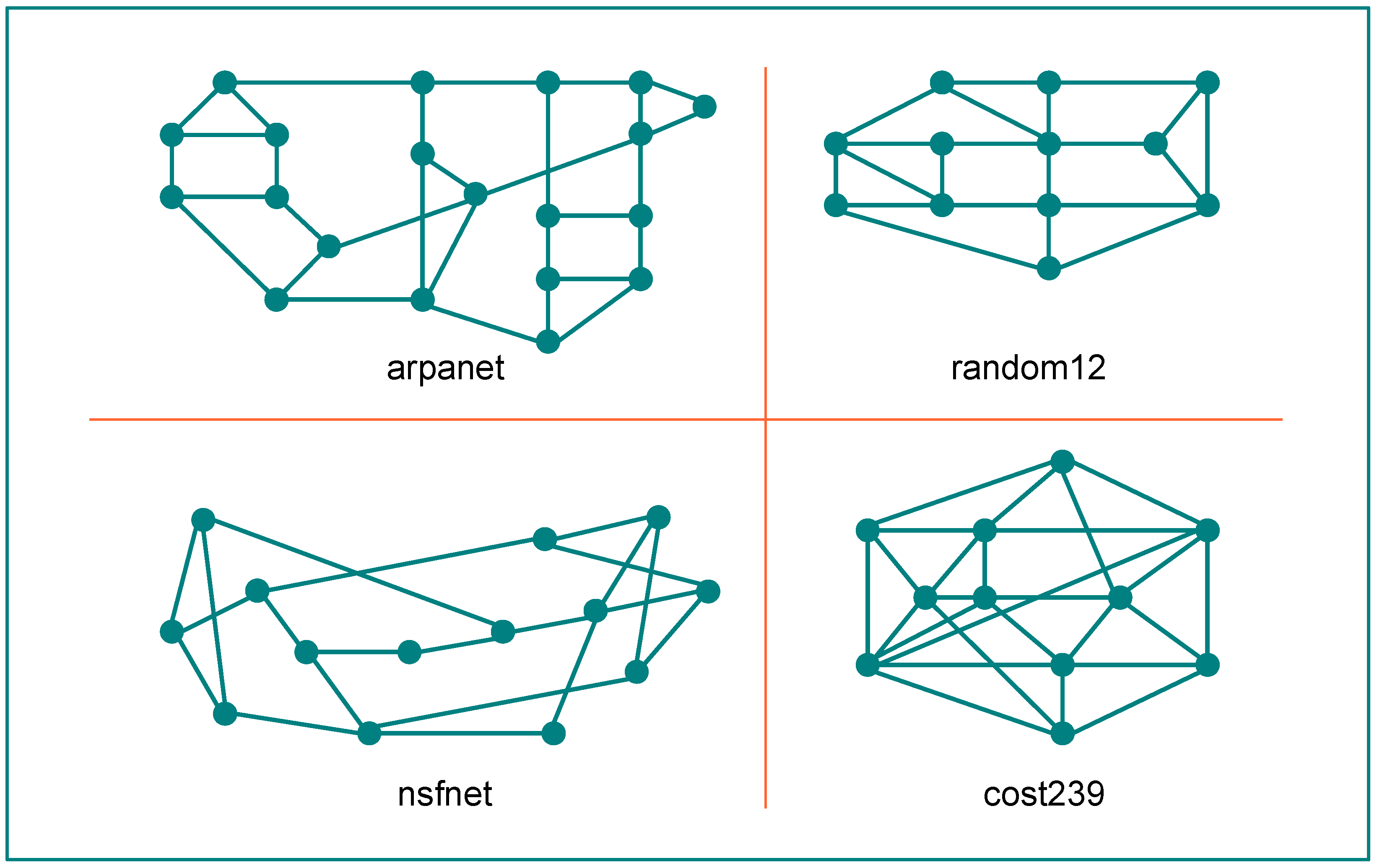
| Network | Num of | Num of | Degree | Connectivity | |
|---|---|---|---|---|---|
| nodes | links | (av) | (stdev) | ||
| ARPANET | 20 | 62 | 3.1 | 0.45 | 0.16 |
| NSFNET | 14 | 42 | 3.0 | 0.55 | 0.23 |
| RANDOM12 | 12 | 42 | 3.5 | 0.67 | 0.32 |
| COST239 | 11 | 52 | 4.7 | 0.65 | 0.47 |

3.2.1. Edge Node Simulator
3.2.2. Core Node Simulator
4. Routing Strategies
4.1. MCL Path Selection Strategy
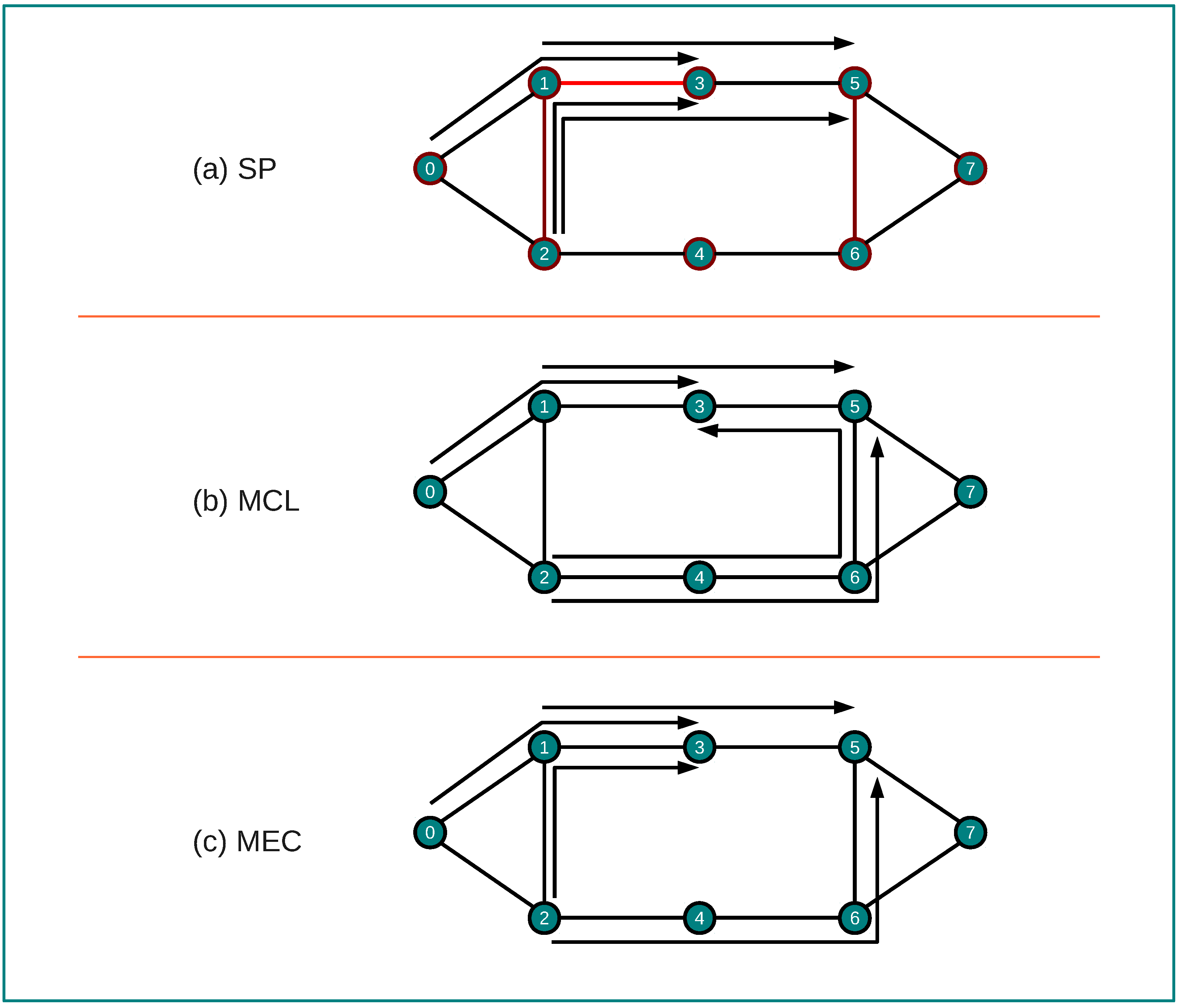
4.2. MEC Path Selection Strategy
4.3. SBPR path selection strategy
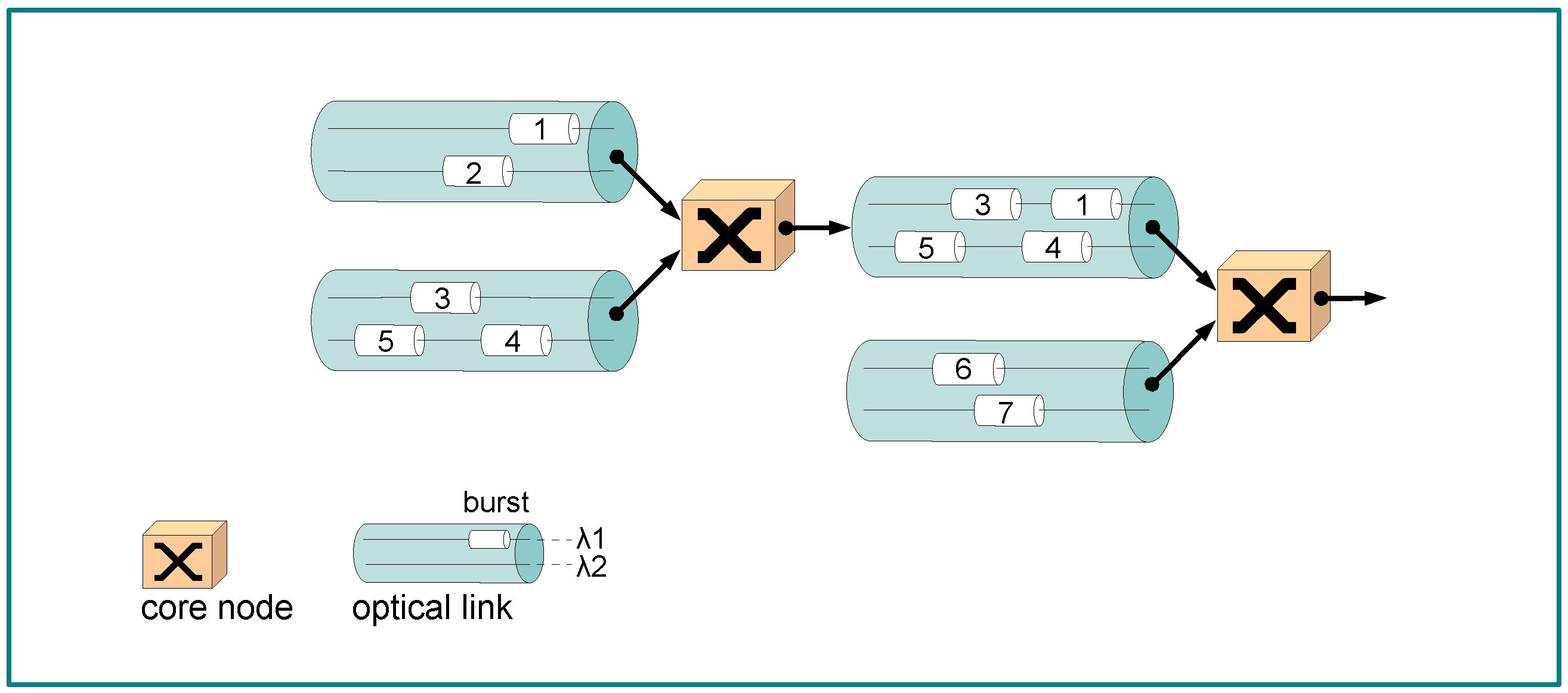
5. Results and Discussion
| MCL | MEC | SBPR | ||
|---|---|---|---|---|
| number of constraints | 442 | 1299220 | 462 | |
| ARPANET | number of variables | 1141 | 1299601 | 1161 |
| total time spent in sec. | 0.02 | 0.01 | ||
| number of constraints | 224 | 297934 | 238 | |
| NSFNET | number of variables | 547 | 298117 | 561 |
| total time spent in sec. | 0.02 | 0.02 | ||
| number of constraints | 174 | 156684 | 186 | |
| RANDOM12 | number of variables | 397 | 156817 | 409 |
| total time spent in sec. | 0.01 | 0.01 | ||
| number of constraints | 162 | 108790 | 173 | |
| COST239 | number of variables | 331 | 108901 | 342 |
| total time spent in sec. | 0.02 | 0.02 |
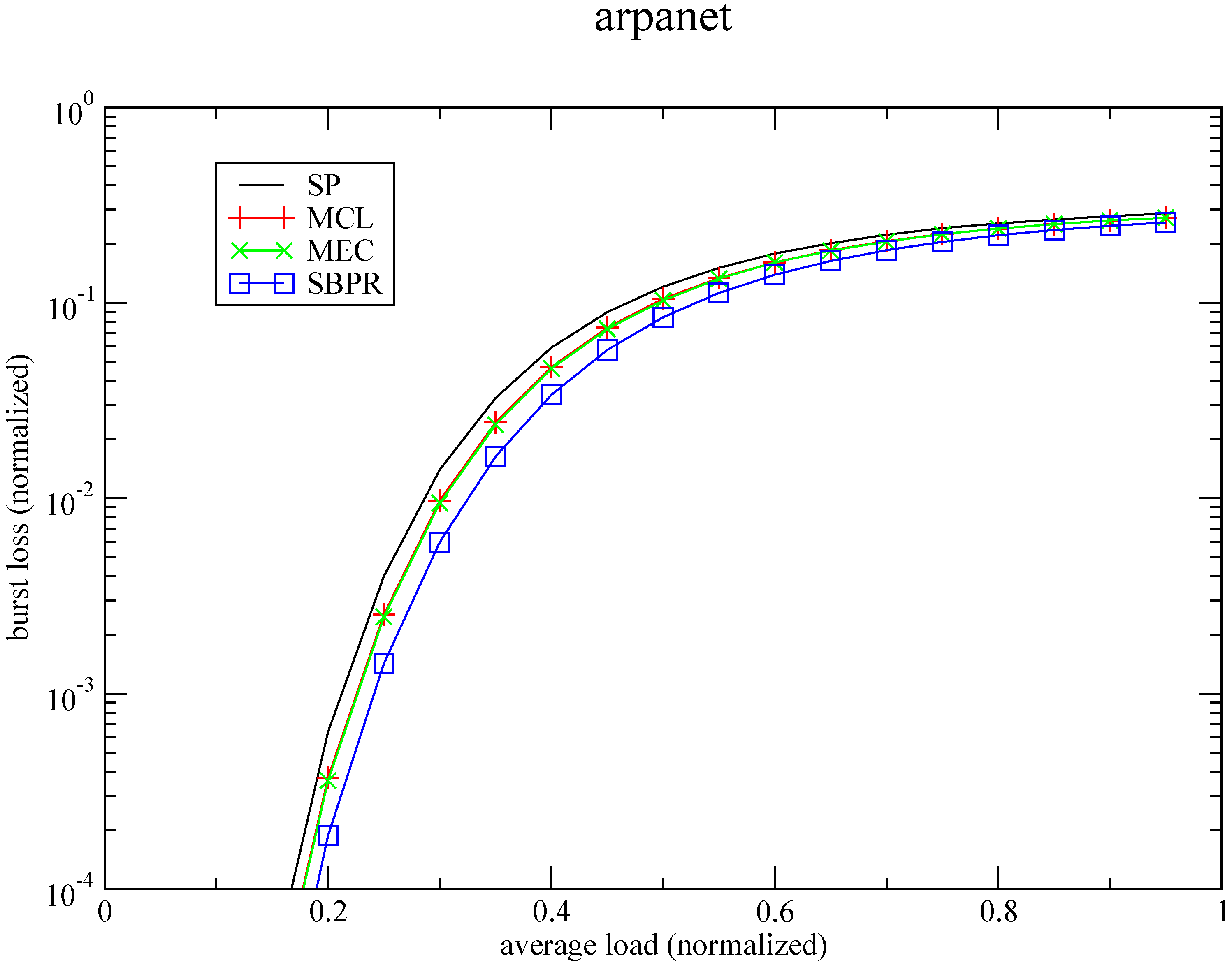
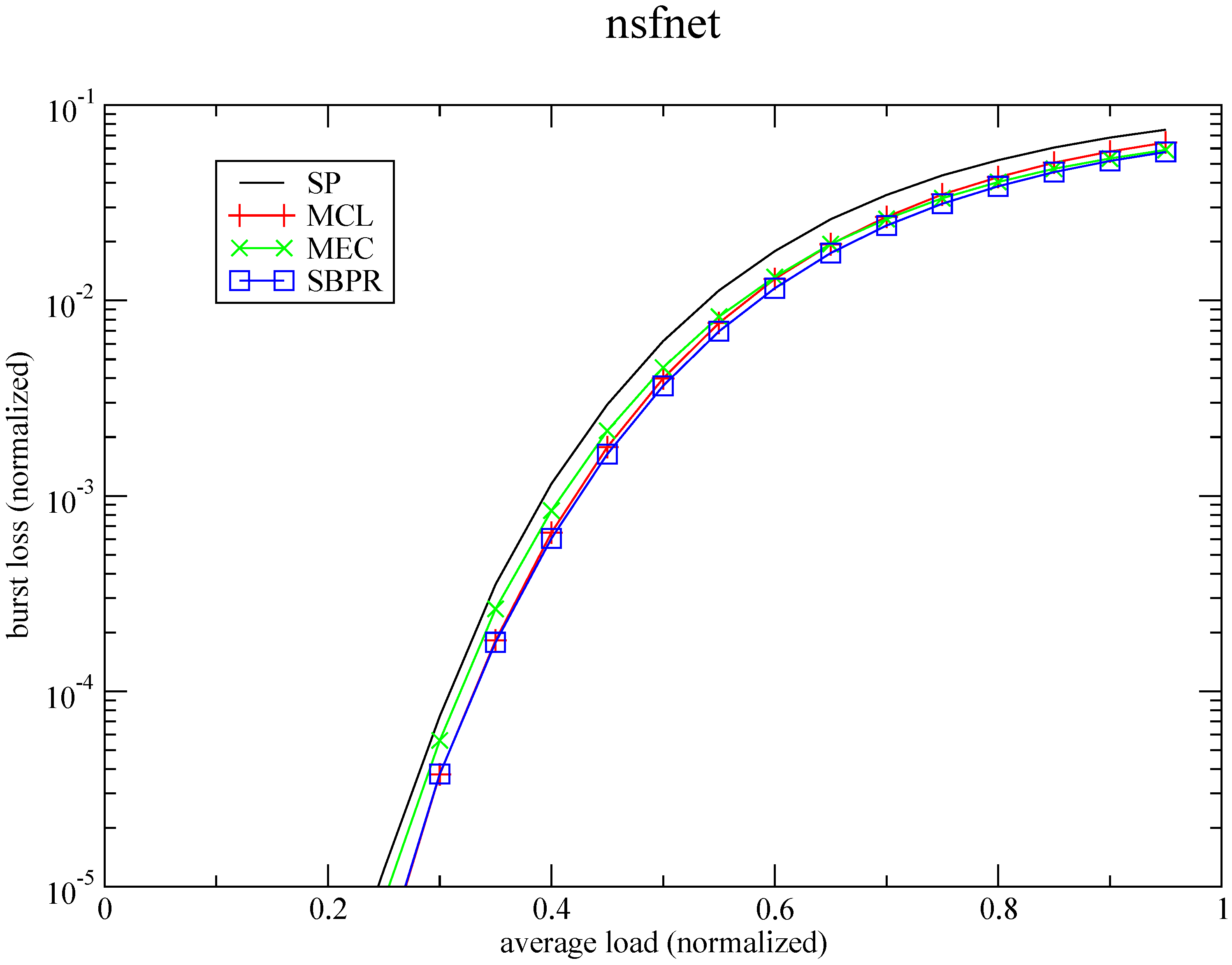
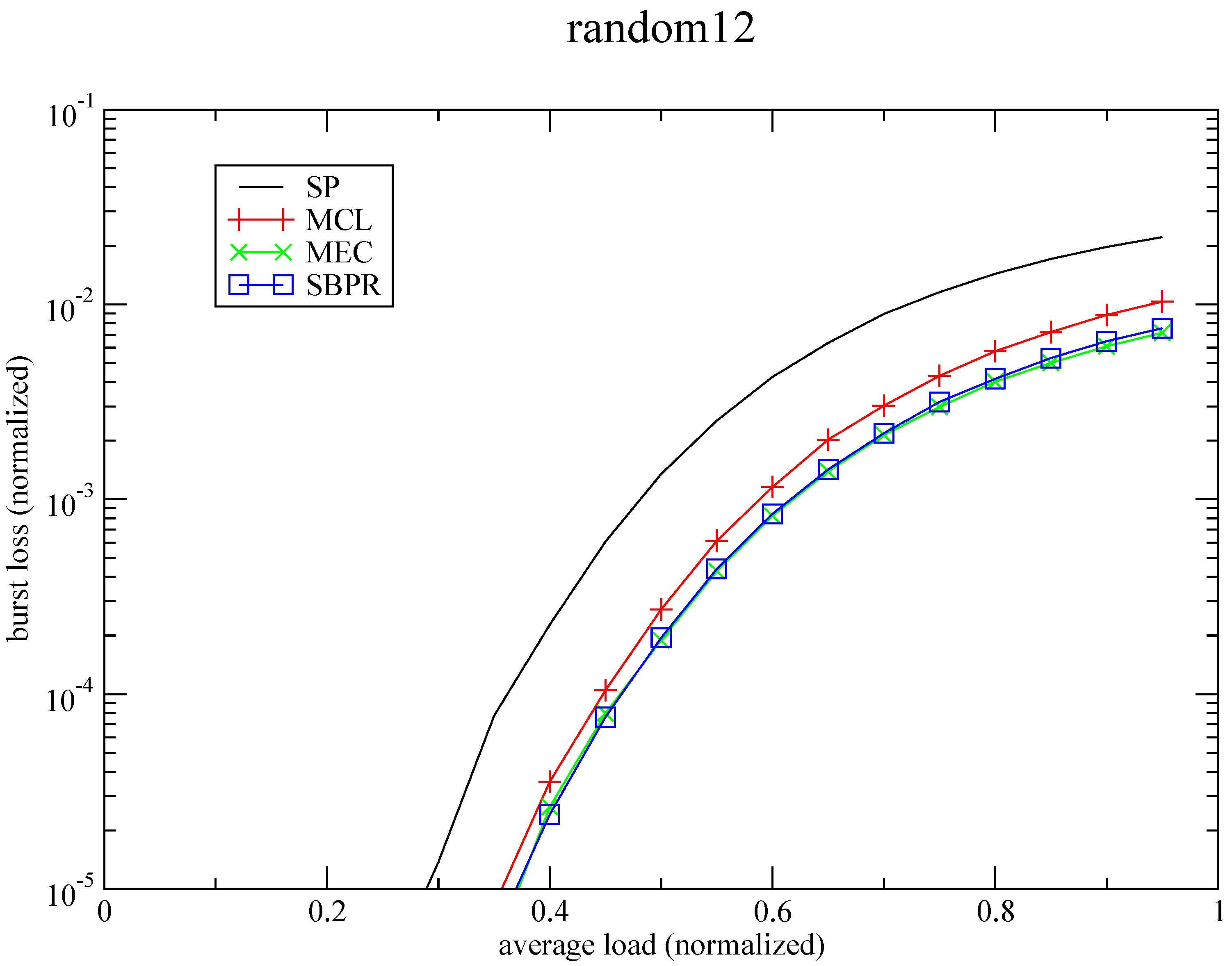
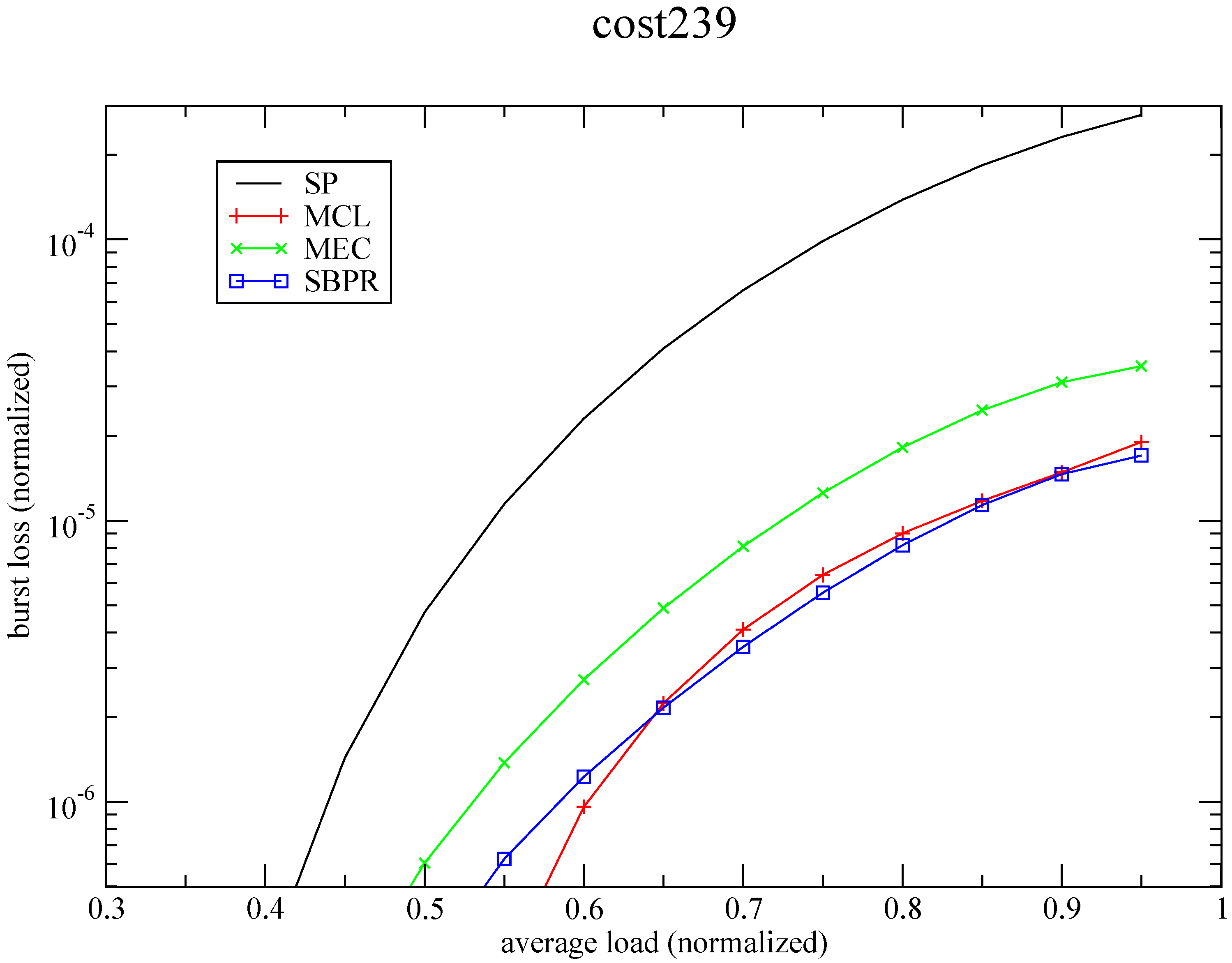
6. Conclusions
Acknowledgments
References
- Qiao, C.; Yoo, M. Optical Burst Switching (OBS)—A New Paradigm for an Optical Internet. JHSN 1999, 8, 69–84. [Google Scholar]
- Chen, Y.; Qiao, C.; Yu, X. Optical burst switching: A new area in optical networking research. IEEE Network 2004, 18, 16–23. [Google Scholar] [CrossRef]
- Xiong, Y.; Vandenhoute, M.; Cankaya, H. Control architecture in optical burst-switched WDM networks. IEEE J. Sel. Areas Commun. 2000, 18, 1838–1851. [Google Scholar] [CrossRef]
- Li, J.; Qiao, C. Recent progress in the scheduling algorithms in optical-burst-switched networks. J. Opt. Netw. 2004, 3, 229–241. [Google Scholar] [CrossRef]
- Jue, J.P.; Vokkarane, V.M. Optical Burst Switched Networks; Springer: New York, NY, USA, 2005. [Google Scholar]
- Vokkarane, V.; Vokkarane, V.; Jue, J. Prioritized burst segmentation and composite burst-assembly techniques for QoS support in optical burst-switched networks. IEEE J. Sel. Areas Commun. 2003, 21, 1198–1209. [Google Scholar] [CrossRef]
- Jin, M.; Yang, O.W. Provision of differentiated performance in Optical Burst Switching networks based on burst assembly processes. Comput. Commun. 2007, 30, 3449–3459. [Google Scholar] [CrossRef]
- Zhang, Q.; Zhang, Q.; Vokkarane, V.; Jue, J.; Chen, B. Absolute QoS differentiation in optical burst-switched networks. IEEE J. Sel. Areas Commun. 2004, 22, 1781–1795. [Google Scholar] [CrossRef]
- Teng, J.; Rouskas, G. Wavelength Selection in OBS Networks Using Traffic Engineering and Priority-Based Concepts. IEEE J. Sel. Areas Commun. 2005, 23, 1658–1669. [Google Scholar] [CrossRef]
- Teng, J.; Rouskas, G.N. Traffic engeneering approach to path selection in optical burst switching networks. OSA J. Opt. Netw. 2005, 4, 759–777. [Google Scholar] [CrossRef]
- Li, J.; Mohan, G.; Chua, K. Dynamic load balancing in IP-over-WDM optical burst switching networks. Comput. Netw. 2005, 47, 393–408. [Google Scholar] [CrossRef]
- Gonzalez-Ortega, M.A.; Lopez-Ardao, J.C.; Rodriguez-Rubio, R.F.; Lopez-Garcia, C.; Fernandez-Veiga, M.; Suarez-Gonzalez, A. Performance analysis of adaptive multipath load balancing in WDM-LOBS networks. Comput. Commun. 2007, 30, 3460–3470. [Google Scholar] [CrossRef]
- Barradas, A.L.; Medeiros, M.C.R. Edge-Node Deployed Routing Strategies for Load Balancing in Optical Burst Switched Networks. ETRI J. 2009, 31, 31–41. [Google Scholar] [CrossRef]
- Barradas, A.L.; Medeiros, M.C.R. Pre-planned optical burst switched routing strategies considering the streamline effect. Photonic Netw. Commun. 2010, 19, 161–169. [Google Scholar] [CrossRef]
- Chen, Q.; Mohan, G.; Chua, K.C. Route optimization in optical burst switched networks considering the streamline effect. Comput. Netw. 2008, 52, 2033–2044. [Google Scholar] [CrossRef]
- Zapata-Beghelli, A.; Bayvel, P. Dynamic Versus Static Wavelength-Routed Optical Networks. J. Lightwave Tech. 2008, 26, 3403–3415. [Google Scholar] [CrossRef]
- Li, K. Heuristic algorithms for routing and wavelength assignment in WDM optical networks. In Proceedings of IEEE International Symposium on Parallel and Distributed Processing IPDPS, Sydney, Australia, December 2008; pp. 1–8.
- Klinkowski, M. Offset Time-Emulated Architecture for Optical Burst Switching—Modeling and Performance Evaluation. PhD Thesis, Department d’Arquitectura de Computadores, Universitat Politecnica de Catalunya, Barcelona, Spain, November 2007. [Google Scholar]
- Farahmand, F.; Vokkarane, V.M.; Jue, J.P.; Rodrigues, J.J.P.C.; Freire, M.M. Optical burst switching network: A multi-layered approach. J. High Speed Netw. 2007, 16, 105–122. [Google Scholar]
- Maier, M. Optical burst switching. In Optical Switching Networks; Cambridge University Press: New York, NY, USA, 2008; Chapter 9; pp. 103–134. [Google Scholar]
- Azodolmolky, S.; Tzanakaki, A.; Tomkos, I. Study of the Impact of Burst Assembly Algorithms in Optical Burst Switched Networks with Self-Similar Input Traffic. Transparent Opt. Network. 2006, 3, 35–40. [Google Scholar]
- Sarwar, S.; Wallentin, L.; Franzl, G.; van As, H.R. Composite burst assembly with high-priority packets in the middle of burst. In Proceedings of BROADNETS 2008: The 5th International Conference on Broadband Communications, Networks and Systems, London, UK, September 2008; pp. 140–145.
- Jue, J.P.; Vokkarane, V.M. Signaling. In Optical Burst Switched Networks; Springer: New York, NY, USA, 2005; Chapter 4; pp. 37–56. [Google Scholar]
- Vokkarane, V.M. Intermediate-node-initiation (INI): A generalized signaling framework for optical burst-switched networks. Opt. Switching Netw. 2007, 4, 20–32. [Google Scholar] [CrossRef]
- Mannie, E.E.A. Generalized Multi-Protocol Label Switching (GMPLS) Architecture. RFC 2004, RFC 3945. [Google Scholar]
- Battestilli, T.; Perros, H. An introduction to optical burst switching. IEEE Commun. Mag. 2003, 41, S10–S15. [Google Scholar] [CrossRef]
- Chua, K.C.; Gurusamy, M.; Liu, Y.; Phung, M.H. Edge-to-edge QoS Mechanisms. In Quality of Service in Optical Burst Switched Networks; Springer: New York, NY, USA, 2007; Chapter 5; pp. 111–176. [Google Scholar]
- Praveen, B.; Praveen, J.; Murthy, C.S.R. A survey of differentiated QoS schemes in optical burst switched networks. Opt. Switching Netw. 2006, 3, 134–142. [Google Scholar] [CrossRef]
- Klinkowski, M.; Careglio, D.; Spadaro, S.; Sole-Pareta, J. Impact of burst length differentiation on QoS performance in OBS networks. In Proceedings of 7th International Conference Transparent Optical Networks, Barcelona, Spain, July 2005; Volume 1, pp. 91–94.
- Vokkarane, V.; Vokkarane, V.; Zhang, Q.; Jue, J.; Chen, B. Generalized burst assembly and scheduling techniques for QoS support in optical burst-switched networks. In Proceedings of GLOBECOM ’02: IEEE Global Telecommunications Conference, Taipei, Taiwan, November 2002; Volume 3, pp. 2747–2751.
- Arakawa, Y.; Sakuta, M.; Sasase, I. QoS scheme with burst dropping in optical burst switching. In Proceedings of IEEE Pacific Rim Conference on Communications, Computers and signal Processing, Victoria, Canada, August 2003; Volume 1, pp. 397–400.
- Chen, Y.; Hamdi, M.; Tsang, D. Proportional QoS over OBS networks. In Proceedings of GLOBECOM ’01: IEEE Global Telecommunications Conference, San Antonio, TX, USA, November 2001; Volume 3, pp. 1510–1514.
- Zhang, Q.; Vokkarane, V.; Chen, B.; Jue, J. Early drop scheme for providing absolute QoS differentiation in optical burst-switched networks. In Proceedings of 2003 Workshop on HPSR High Performance Switching and Routing, Torino, Italy, June 2003; pp. 153–157.
- Zhang, Q.; Vokkarane, V.; Chen, B.; Jue, J. Early drop and wavelength grouping schemes for providing absolute QoS differentiation in optical burst-switched networks. In Proceedings of GLOBECOM ’03: IEEE Global Telecommunications Conference, San Francisco, CA, USA, December 2003; Volume 5, pp. 2694–2698.
- Yoo, M.; Qiao, C. New optical burst-switching protocol for supporting quality of service. In All-Optical Networking: Architecture, Control, and Management Issues; Senior, J.M., Qiao, C., Eds.; SPIE: Boston, MA, USA, November 1998; Volume 3531, pp. 396–405. [Google Scholar]
- Yoo, M.; Qiao, C. Supporting multiple classes of services in IP over WDM networks. In Proceedings of GLOBECOM ’99: Global Telecommunications Conference, Rio de Janeiro, Brazil, December 1999; Volume 1B, pp. 1023–1027.
- Yoo, M.; Qiao, C.; Dixit, S. QoS performance of optical burst switching in IP-over-WDM networks. IEEE J. Sel. Areas Commun. 2000, 18, 2062–2071. [Google Scholar]
- Vu, H.L.; Zukerman, M. Blocking probability for priority classes in optical burst switching networks. IEEE Commun. Lett. 2002, 6, 214–216. [Google Scholar]
- Mikoshi, T.; Takenaka, T. Improvement of burst transmission delay using offset time for burst assembly in optical burt switching. In Proceedings of 7th Asia-Pacific Symposium on Information and Telecommunication Technologies, Bandos Island, Maldives, April 2008; pp. 13–18.
- Liu, J.; Ansari, N.; Ott, T. FRR for latency reduction and QoS provisioning in OBS networks. IEEE J. Sel. Areas Commun. 2003, 21, 1210–1219. [Google Scholar]
- Loi, C.H.; Liao, W.; Yang, D.N. Service differentiation in optical burst switched networks. In Proceedings of GLOBECOM ’02: IEEE Global Telecommunications Conference, Taipei, Taiwan, November 2002; Volume 3, pp. 2313–2317.
- Guan, X.; Thng, I.L.J.; Jiang, Y.; Li, H. Providing absolute QoS through virtual channel reservation in optical burst switching networks. Comput. Commun. 2005, 28, 967–986. [Google Scholar] [CrossRef]
- Phung, M.H.; Chua, K.C.; Mohan, G.; Motani, M.; Wong, T.C. An Absolute QoS Framework for Loss Guarantees in Optical Burst-Switched Networks. IEEE Trans. Commun. 2007, 55, 1191–1201. [Google Scholar] [CrossRef]
- Marchetto, G. Minimizing Preemption Probability to Efficiently Support Service Differentiation in Just-in-Time Based OBS Networks. In Proceedings of ICC ’08: IEEE International Conference on Communications, Beijing, China, May 2008; pp. 5219–5223.
- Yang, L.; Jiang, Y.; Jiang, S. A probabilistic preemptive scheme for providing service differentiation in OBS networks. In Proceedings of GLOBECOM ’03: IEEE Global Telecommunications Conference, San Francisco, CA, USA, December 2003; Volume 5, pp. 2689–2693.
- Tan, C.W.; Mohan, G.; Lui, J.S. Achieving Multi-Class Service Differentiation in WDM Optical Burst Switching Networks: A Probabilistic Preemptive Burst Segmentation Scheme. IEEE J. Sel. Areas Commun. 2006, 24, 106–119. [Google Scholar]
- Gonzalez-Ortega, M.; Lopez-Ardao, J.; Lopez-Garcia, C.; Argibay-Losada, P.; Rodriguez-Rubio, R.; Pineiro-Valladares, M. Loss differentiation in OBS networks without wavelength-conversion capability. IEEE Commun. Lett. 2008, 12, 903–905. [Google Scholar] [CrossRef]
- Liu, D.; Liu, M. Differentiated services and scheduling scheme in optical burst-switched WDM networks. In Proceedings of 10th IEEE International Conference on Networks, Atlanta, GA, USA, August 2002; pp. 23–27.
- Yang, M.; Zheng, S.; Verchere, D. A QoS supporting scheduling algorithm for optical burst switching WDMM networks. In Proceedings of IEEE Global Telecommunications Conference, San Antonio, TX, USA, November 2001; Volume 1, pp. 86–91.
- Kozlovsky, E.; Bayvel, P. QoS Performance of WROBSS Network Architecture with Request Scheduling. In Next Generation Optical Network Design and Modelling; Kluwer: Torino, Italy, February 2003. [Google Scholar]
- Wen, H.; Song, H.; Li, L.; Wang, S. Load-balancing contention resolution in LOBS based on GMPLS. In Proceedings of PDCAT’2003: the Fourth International Conference on Parallel and Distributed Computing, Applications and Technologies, Chengdu, China, August 2003; pp. 590–594.
- Zhang, J.; Wang, S.; Zhu, K.; Datta, D.; Kim, Y.C.; Mukherjee, B. Pre-planned global rerouting for fault management in labeled optical burst-switched WDM networks. In Proceedings of IEEE GLOBECOM 2004, Dallas, TX, USA, November 2004; Volume 3, pp. 2004–2008.
- Thodime, G.; Vokkarane, V.; Jue, J. Dynamic congestion-based load balanced routing in optical burst-switched networks. In Proceedings of GLOBECOM ’03: IEEE Global Telecommunications Conference, San Francisco, CA, USA, December 2003; Volume 5, pp. 2628–2632.
- Yang, L.; Rouskas, G. Adaptive path selection in OBS networks. J. Lightwave Tech. 2006, 24, 3002–3011. [Google Scholar] [CrossRef]
- Kiran, Y.; Venkatesh, T.; Murthy, C. A Reinforcement Learning Framework for Path Selection and Wavelength Selection in Optical Burst Switched Networks. IEEE J. Sel. Areas Commun. 2007, 25, 18–26. [Google Scholar] [CrossRef]
- Phung, M.; Chua, K.; Mohan, G.; Motani, M.; Wong, T. The streamline effect in OBS networks and its application in load balancing. In Proceedings of 2nd International Conference on Broadband Networks, Boston, MA, USA, October 2005; Volume 1, pp. 283–290.
- Chen, Q.; Mohan, G.; Chua, K.C. Offline Route Optimization Considering Streamline Effect in Optical Burst Switching Networks. In Proceedings of ICC ’06: IEEE International Conference on Communications, Istanbul, Turkey, June 2006; Volume 6, pp. 2562–2567.
- IBM ILOG CPLEX home page. Available online: http://www-01.ibm.com/software/integration/optimization/cplex/ (accessed on 21 October 2010).
- OMNeT++ home page. Available online: http://www.omnetpp.org (accessed on 21 October 2010).
- Yu, X.; Li, J.; Cao, X.; Chen, Y.; Qiao, C. Traffic statistics and performance evaluation in optical burst switched networks. J. Lightwave Tech. 2004, 22, 2722–2738. [Google Scholar] [CrossRef]
- Baroni, S.; Bayvel, P. Wavelength requirements in arbitrarily connected wavelength-routed optical networks. J. Lightwave Tech. 1997, 15, 242–251. [Google Scholar] [CrossRef]
- Ge, A.; Callegati, F.; Tamil, L. On optical burst switching and self-similar traffic. IEEE Commun. Lett. 2000, 4, 98–100. [Google Scholar] [CrossRef]
- Izal, M.; Aracil, J. On the influence of self-similarity on optical burst switching traffic. In Proceedings of GLOBECOM ’02: IEEE Global Telecommunications Conference, Taipei, Taiwan, November 2002; Volume 3, pp. 2308–2312.
- Vokkarane, V.M.; Haridoss, K.; Jue, J.P. Threshold-based burst assembly policies for QoS support in optical burst-switched networks. In Proceedings of SPIE OptiComm 2002, Boston, MA, USA, July 2002; pp. 125–136.
- Gjessing, S.; Maus, A. Discrete Event Simulation of a large OBS Network. In Proceedings of International Conference on Systems, Man and Cybernetics, Big Island, HI, USA, October 2005.
- Chua, K.C.; Gurusamy, M.; Liu, Y.; Phung, M.H. Quality of Service in Optical Burst Switched Networks; Springer: New York, NY, USA, 2007. [Google Scholar]
- Phung, M.; Shan, D.; Chua, K.; Mohan, G. Performance analysis of a bufferless OBS node considering the streamline effect. IEEE Commun. Lett. 2006, 10, 293–295. [Google Scholar] [CrossRef]
- Rodrigues, J.J.P.C.; Freire, M.M.; Lorenz, P. The Role of Meshing Degree in Optical Burst Switching Networks Using Signaling Protocols with One-Way Reservation Schemes. Lect. Notes Comput. Sci. 2005, 3420, 44–51. [Google Scholar]
- Masip-Bruin, X.; Yannuzzi, M.; Domingo-Pascual, J.; Fonte, A.; Curado, M.; Monteiro, E.; Kuipers, F.; Mieghem, P.V.; Avallone, S.; Ventre, G.; Aranda-Gutirrez, P.; Hollick, M.; Steinmetz, R.; Iannone, L.; Salamatian, K. Research challenges in QoS routing. Comput. Commun. 2006, 29, 563–581. [Google Scholar] [CrossRef] [Green Version]
© 2010 by the authors; licensee MDPI, Basel, Switzerland. This article is an open access article distributed under the terms and conditions of the Creative Commons Attribution license ( http://creativecommons.org/licenses/by/3.0/.)
Share and Cite
Barradas, A.L.; Medeiros, M.d.C.R. An Intrinsic TE Approach for End-to-End QoS Provisioning in OBS Networks Using Static Load-Balanced Routing Strategies. Future Internet 2010, 2, 559-586. https://doi.org/10.3390/fi2040559
Barradas AL, Medeiros MdCR. An Intrinsic TE Approach for End-to-End QoS Provisioning in OBS Networks Using Static Load-Balanced Routing Strategies. Future Internet. 2010; 2(4):559-586. https://doi.org/10.3390/fi2040559
Chicago/Turabian StyleBarradas, Alvaro L., and Maria do Carmo R. Medeiros. 2010. "An Intrinsic TE Approach for End-to-End QoS Provisioning in OBS Networks Using Static Load-Balanced Routing Strategies" Future Internet 2, no. 4: 559-586. https://doi.org/10.3390/fi2040559




